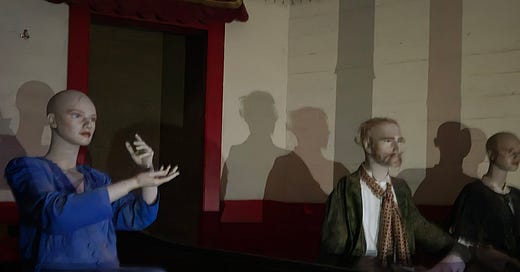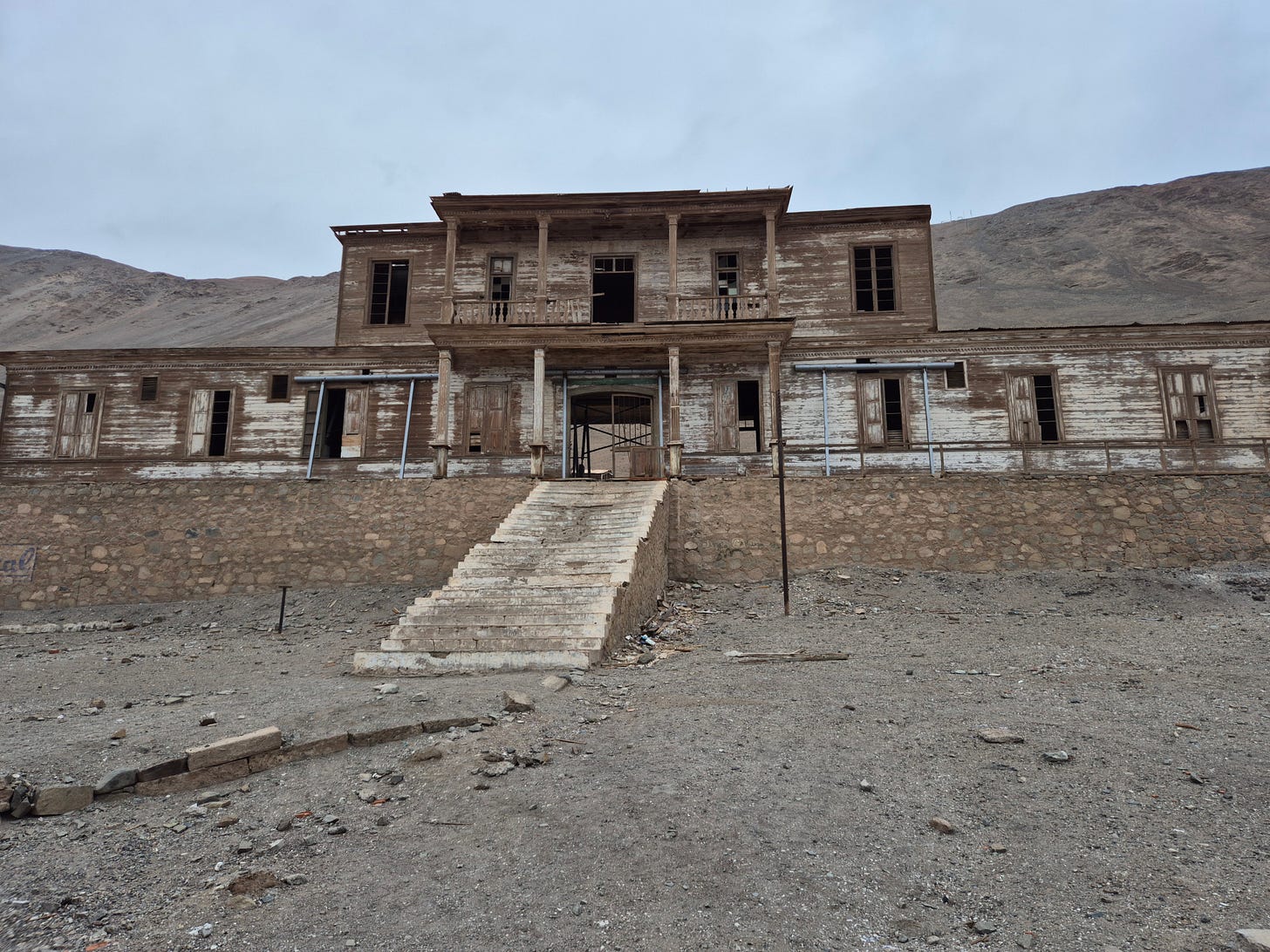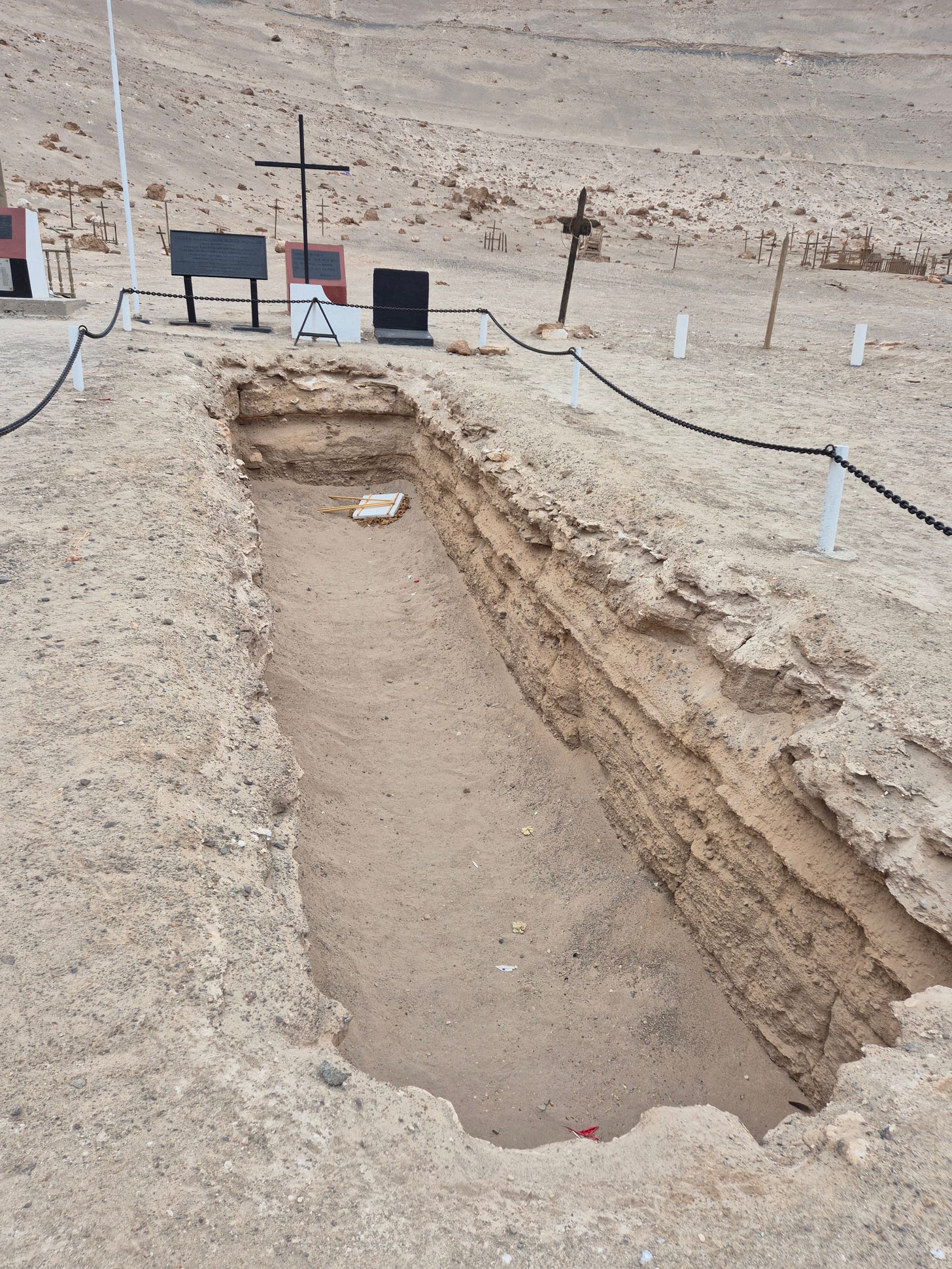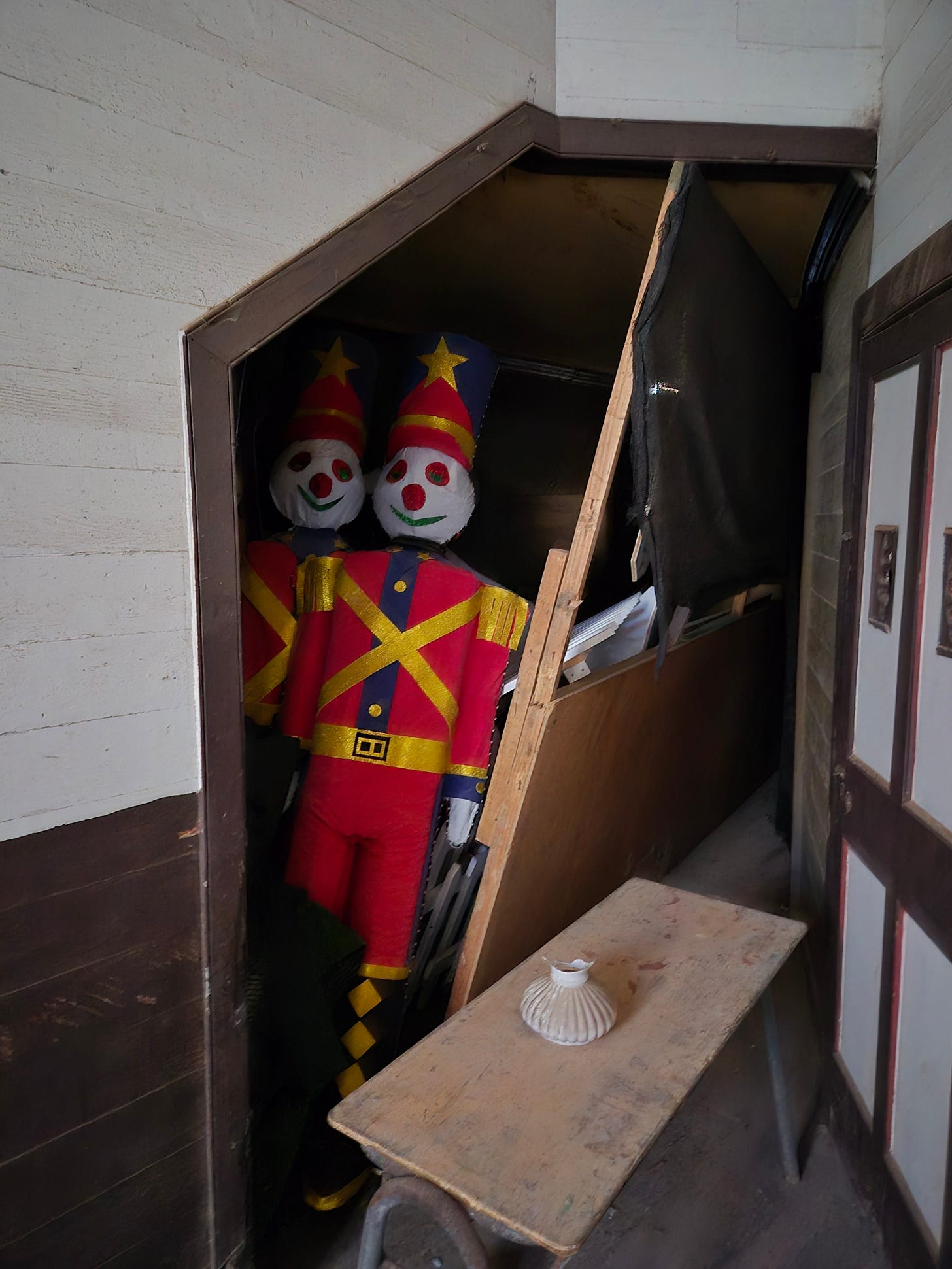Pisagua doesn’t feature in many tourist itineraries of the Atacama. Few non-Chileans have even heard of it. But for many Chileans, Pisagua has very particular associations. There was a time when soccer fans who disliked certain referees chanted ‘send him to Pisagua’, and parents would terrify their wayward children by threatening to send them there.
This spooky reputation is partly due to Pisagua’s remoteness. Pisagua lies some 1,200 miles from Santiago on the edge of the Atacama desert, and is still difficult to reach.
We had to hire a driver to take us there, who drove some 101 miles along the Pan-American highway from Iquique, before turning off onto the lonely, twisting road that leads down from the coastal cordillera. The only sign of human habitation in the barren, desolate hills was a humble wooden cemetery where Chinese slaves who once worked on the nineteenth century guano trade were buried.
After about twenty minutes, Pisagua appeared below us, flanked by looming cliffs that enhanced its gloomy end-of-the-world isolation.
In other countries, this beautiful sheltered bay might have attracted divers and a niche touristic destination, and Pisagua wasn’t always as remote as it is now. During the 1890-1914 nitrate boom, the town was one of Chile’s top three ports, with a population of 26,000. At that time it boasted an elegant wooden hospital, banks, commercial houses, hotels, and a highly-rated theatre that entertained the crews and passengers of clipper ships that queued up in the little bay to transport nitrate to European and American ports.
Today, those glory days are long gone, and some 300 people eke out a living from fishing or collecting algae, amongst the dilapidated houses, shacks, and ruined public buildings. The hospital, the railway station, and most of its public buildings have been reduced to hollow shells.
Anywhere else but the Atacama, Pisagua’s wooden buildings would have rotted away and collapsed a long time ago, but here the imported Oregon-pine facades still bear witness to the decline of a once-great industry that, in Pisagua at least, has never found a replacement.
Like the Atacama’s other coastal towns, Pisagua is prone to earthquakes, tsunamis and plagues; outbreaks of bubonic plague and yellow fever decimated the population on successive occasions before World War I. In 1828 and 1868, earthquakes destroyed the town. Because so many of its buildings were built from imported wood, it was also susceptible to fires. In April 1879, a Chilean naval bombardment burned much of it down during the War of the Pacific. On 2 November, the Chilean military carried out the first amphibian assault in modern history, and took the town from its Peruvian/Bolivian defenders.
In 1905 another fire caused equal levels of devastation. Despite these periodic disasters, it wasn’t until the decline of the nitrate trade in the 1930s, that the town fell into terminal disrepair from which it has never recovered. And it was in this period that Pisagua began to acquire the sinister reputation that led our driver to reflect on its ‘bad vibrations.’
Because of its geographical isolation, Pisagua’s abandoned buildings and prison have repeatedly provided successive authoritarian governments with a detention centre/concentration camp for political prisoners and other undesirables. In 1942, it was used to detain homosexuals and other ‘socially maladjusted’ individuals. During the 1940s and early 1950s, communists were imprisoned there.
Augusto Pinochet served there in this period as a young officer, and once tried to prevent Salvador Allende - then a senator in the Chilean north - from inspecting the facilities where these prisoners were kept. When Pinochet let the coup that overthrew Allende in 1973, Pisagua became a detention camp once again, where the army imprisoned, tortured and killed Allende’s supporters.
According to the 1990 Chilean Truth and Reconciliation Commission, detainees were interrogated, beaten and given electric shocks, forced to do hard labour, perform exhausting physical exercises, such as trying to climb ladders while soldiers attempted to push them over. Others were forced to lie on the ground in the cold or heat for 48-hour periods, and women prisoners were also subjected to sexual violence.
The Chilean historian Karelia Cerda has described Pisagua as a key to the consolidation of the Pinochet regime’s power in northern Chile, where psychological and physical violence was inflicted on some 800 prisoners - the better to terrorise the wider population and annihilate the political generation that brought Allende to power.
The military authorities who ran the Pisagua camp also carried out summary executions and forced disappearances. In 1973 and 1974, some prisoners were sentenced to death by summary court martial. Others were supposedly shot trying to escape. The Chilean Truth and Reconciliation Commission dismissed the legal legitimacy of these courts and also rejected the notion that prisoners had tried to escape.
Any visitor to Pisagua will see that it is virtually impossible to escape from. The open grave you see below once contained the bodies of 21 men, including Ariel Dorfman’s boyhood friend, the young socialist leader Freddy Tavernas, whose bodies were excavated in 1990. Other prisoners killed at Pisagua have never been found.
Today, a memorial marks the spot, with a quotation from Pablo Neruda, above the beach that Chilean soldiers once stormed in 1879.
Only a few dozen yards from the grave, the Chilean military has its own monument to the 1879 landings, and rows of wooden cemeteries mark the graves of Chilean, Peruvian and Bolivian soldiers who died that day.
This is a lot of history for even a large town to bear. Every year, leftist delegations, including former prisoners and their relatives, come to this spot to pay homage to the victims, as part of an ongoing process of historical remembrance. And every year the Chilean army stages a commemorative event on the anniversary of the 1879 landings. Individual former detainees also return periodically to Pisagua. Some come to remember former comrades or seek some psychological release. Families of disappeared prisoners occasionally carry out exhumations, in search of the remains of executed relatives who the military has taken responsibility for.
Only two weeks before our visit, according to local guides Marcia and Camila, a retired soldier who had served in Pisagua during the Pinochet years, had returned to the town, to ask the Virgin Mary forgiveness for having stolen money from the church collection box, to buy a can of tuna fish to appease his hunger.
It was bewildering and disorientating to contemplate the physical traces of so many tragic histories. During the Pinochet dictatorship, detainees were kept in the former market, the prison and also in the illustrious theatre where, it was said, the ‘Divine Sarah’ Bernhardt may once have performed. According to one of our guides, the military forced prisoners to take part in obligatory theatrical ‘competitions’ which the ‘losers’ were punished with death.
Today, the theatre is still used periodically, as part of ‘Project Pisagua’ - an attempt by local and regional campaigners to give Pisagua a viable future. For now, the town remains trapped by its grim past. In one of the balconies of the eerie but still recognisably splendid theatre, bald mannequins of former ‘English’ patrons from the nitrate years looked towards the stage, their hands frozen in applause.
Someone had stolen their wigs, and they sat frozen in the gloom, like ghastly apparitions from a film that Adam Curtis might have made. As I turned to leave the theatre, I passed another mannequin of a grinning clown-soldier, that had fallen out of a cupboard.
If history, to paraphrase James Joyce, was a nightmare from which we are all trying to awake, then Pisagua was a microcosm of Chile’s own passage through the sewers of Cold War history. But this history is also part of our history. The regime that turned this town into a prison-cum-death camp was an ally of the United States and Britain. General Pinochet was a personal friend of Margaret Thatcher. Her government borrowed heavily from his economic program. He escaped trial because of the cowardice and collusion of the Blair government.
The men and women his soldiers killed and tortured were guilty of the audacity of wanting a more equal society, and believed that they could achieve through a peaceful democratic process.
The coup shattered that dream. And Pisagua’s House of Horrors, was part of the nightmare that followed. Today the world is stalked by political forces that are just as capable of the cruelty and violence cruelty that Margaret Thatcher’s favourite general inflicted on the Chilean left, in Pisagua and in many other places. Like the boy in a mural that I noticed as we left, humanity is increasingly alone and adrift on a stormy political sea with no harbour in sight.
Pisagua is the town that history swallowed and spat out, and yet still there are people like our valiant guides Marcia and Camilla, who refuse to let it die, and are seeking to build a future from its ruins.
And when I think of Pisagua, I think of them. And perhaps those of us who will never go to Pisagua, should think not just of the torturers and executioners who turned this outpost of Chilean Siberia into yet another Cold War theatre of cruelty.
They should also think of the men and women they tormented and killed, and imagine them living, breathing, talking, and dreaming of a world that is still out there, waiting to be built.











Brilliant, informative writing. The crimes of the recent past rendered clear, saved from oblivion, and brought into the light of history.